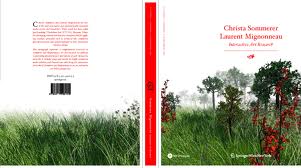Interactive Plant Growing
A mail from Christa Sommerer and Laurent Mignonneau, on april 2013.
As you mentioned in your book, yes we are not only interested in generative art as such
but mostly come from a background in interactive art/partcipatory art and look at how
viewers can get involved in the creation process of the work. Our main objective is interactivity.
Recently we actually deal more with conceptual questions of interactivity and issues of value and the relationship between
the artists, the artwork and the audience. Please see our website for recent works (for example The Value of Art).
And for the question of the plants as interfaces in Interactive Plant Growing (you mention it in our book):
the plants work like antenna that capture the users body electricity, the main goal is to
provide individualized interaction parameters and in this way create individualized images.
Please find here a short text from our monograph (*) that explains the details :

Interactive Art Research
One of the first interactive computer art installations to use a
natural interface instead of the then-common devices such as
joysticks, mouse, trackers or other technical interfaces is our
installation Interactive Plant Growing (1992).
In this installation,
living plants function as the interface between the
human user and the artwork. Users engage in a dialog with
the plants by touching or merely approaching them.
The electrical potential differences (voltage) between the plant
and the user’s body are captured by the plant and interpreted
as electrical signals that determine how the corresponding virtual
3D plants (which look similar to the real plants) grow on
the projection screen. Through modifying the distance between
the user’s hands and the plant, the user can stop, continue, deform
and rotate the virtual plant, as well as develop new plants
and plant combinations. The growth algorithms are programmed
to allow maximum flexibility by taking every voltage
value from the user’s interaction into account. The virtual
plants resulting on screen are always new and different,
creating a complex combined image that depends on the userplant
interaction and the voltage values generated by this interaction.
The user’s hand distance from the real plant generates
voltage values that increase the closer the hand is to the
plant. We employ 5 different distance levels to control the rotation
of the virtual plants, their color values, the place where
they grow on screen as well as the on/ff growth value. The
final result of the interaction is shown on the screen as a collective
image of virtual plants grown by several users.
(*) Interactive Plant Growing 1992, in Interactive Art Research, 2009, by in Gerfried Stocker, Christa Sommerer, Laurent Mignonneau (Eds.). Springer Verlag Vienna/New York, 2009.